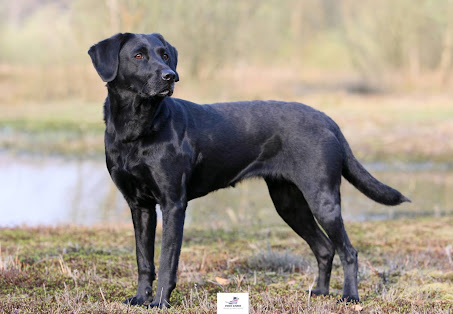Labrador dog breed, Price, Origin, Temperament, Characteristics, best info. 2022

Welcome to our website DogsCares.in here you get the best information related to dogs. In this article we are sharing Knowledge on the Labrador dog breed, Price, Origin, Temperament, Characteristics we hope you like this article.
You can also read these articles:
- Saint Bernard dog breed
- Dalmatian dog breed
- Shih Tzu dog breed
- Tibetan mastiff dog breed
- Chihuahua dog breed
- Horgi dog breed
Labrador dog breed information

Both a companion dog and a working dog breed, the Labrador retriever excels at being both. Fishing nets, fetching ropes, and retrieving fish from the chilly North Atlantic was how they earned their keep historically.
Despite being the most popular breed in America, today’s Labs are equally friendly and hardworking as their ancestors. Today’s Labrador retrievers serve as hunting dogs, assistance dogs, show competitors, and search and rescue dogs, among other duties.
AKC records Labrador retrievers as the top breed in America due to their warmth and intelligence. The loyal companion who waits patiently by their owner’s side–usually as the loyal companion of artists and photographers–can be recognized even by those who aren’t dog lovers.
Muscular and athletic, the Lab was designed for sport. Despite their short coat and easy care, they are friendly and intelligent and have a lot of energy. Dog owners and fans of this breed are devoted to this breed because Labrador retrievers are loving, people-oriented dogs that live to serve their families. Labradors have been compared to angels by owners and fans.
Newfoundland originated on Canada’s northeastern Atlantic coast, on the island of Newfoundland. As St. John’s dogs, after the capital city of Newfoundland, they were bred to assist local fishermen by hauling nets, fetching ropes, and retrieving fish from the nets, in addition to being a family pet.
Modern labs don’t work hard anymore. Instead, they enjoy being pampered and loved by their owners. Still, some Labradors serve as unavoidable working dogs.
Because of their sweet nature, Labradors are ideal therapy dogs, who make excellent hospital and home visits, as well as assistance dogs for the disabled. The athletic build, strong nose, and courageous nature of these dogs also make them excellent search and rescue dogs or retriever dogs for hunters. Moreover, Labradors have become the breed of choice for dog sports such as agility and obedience competitions, especially obedience.
Labs are bad at one job: they can’t be watchdogs. Their owners claim that their friendly and helpful Lab will gladly show an intruder where the goods are stowed.
Over the course of its history, the Labrador Retriever has proven its usefulness as a companion for fishermen, a field retriever, a show dog, and a working dog. Throughout her life, she has played one role: great companion and friend.
Labrador dog breed price
The Labrador Retriever is a breed found in several breeds across the United States. It has a solid black, yellow, or chocolate coat, and it has a muscular, short coat without waves. Despite being slightly taller than it is wide, the dog is solidly built.
Chocolate gray or silver is also recognized by AKC. Over the loins, there is a wide hip area and the hindquarters are muscled and strong. As well as being an active and strong dog, it is also good with children and good with other dogs.
The Labrador retriever is loyal, well-mannered, good-natured, and very good-natured. Gundogs are wonderful for this breed. A labrador is also intelligent, adaptable, and gentle, which makes them the ideal pet.
Labrador puppies can cost anywhere between 4000-5000 rupees and one lakh rupees in India. Cost is affected by both the quality and the pedigree of the dog.
A dog of good quality that doesn’t have any genetic issues will cost you 30,000 rupees or more. What makes the prices so different? This is hard to understand. A lab dog who is four years old and one who will be thirty or forty years old are both lab dogs.
Labrador dog breed origin
The Labrador Retriever originated on the island of Newfoundland, off the coast of Canada’s northeast. Since the 1700s, Labrador retrievers have been companions and helpers to the local fishermen. Their name came from the capital city of Newfoundland, St. John.
The dogs spent their days retrieving fish from hooked lines and retrieving fish that had escaped hooks, then returned home each evening to spend time with the fishermen and their families.
The St. John’s dog was believed to have interbred with the Newfoundland dog and other small local dogs despite their heritage not being known.
After noticing the dog’s utility and good disposition, English sportsmen brought a few Labs to England as retrievers for hunting. Eventually, around 1830, the second Earl of Malmesbury ordered St. John’s dogs to be shipped to England. For the first time, the dogs were referred to as Labradors by the third Earl of Malmesbury.
The Malmesbury family and other English folks are credited with saving the Labrador breed from extinction by the 1880s when the breed was nearly extinct. The breed was eradicated in Newfoundland because the government imposed restrictions and taxes. Female puppies were culled from the litter because females were highly taxed, and families were not allowed to keep more than one dog.
Breed recognition of the Labrador Retriever as a distinct breed by the Kennel Club was granted in 1903 in England, where the breed survived. After the American Kennel Club adopted the breed in 1917, British Labrador retrievers were imported to establish the breed in the US in the 1920s and 1930s.
As soon as World War II ended, the Labrador Retriever’s popularity took off, and in 1991, they became the most popular dog registered with the American Kennel Club–and they have held that title ever since. Canada and England also top the list of most popular dogs.
Today, Labs work in a variety of fields, including drug and explosive detection, search and rescue, therapy, and assistance to the disabled and hunters. As well as showing, field, agility, and obedience, they excel in all kinds of dog competitions.
Labrador dog breed characteristics
In general, Labrador retrievers make excellent family dogs, provided you keep in mind that they need exercise and training. Dogs like to have jobs to do, specifically retrieving, as they are bred to work hard and work well.

As long as training has toned down their natural exuberance, Labs are usually good with other dogs, pets, and kids. They are large, powerful dogs that require obedience training at an early age, or else they can drag their owners down the street at will.
Labradors, because of their energetic nature, will chew, dig, and bark excessively when left alone or without adequate exercise.
Some field line dogs turn into perfect couch potatoes at an early age, while others become show line dogs. There’s a problem with chewing because the retrieving urge causes them to fixate on their mouths. Sturdy chew toys, exercise, and training help them overcome this.
Labrador dog breed Care
Labradors should be around their family and are not meant to be backyard dogs. The longer they’re left alone, the more likely they are to tarnish their saintly reputation: A lonely, bored Lab is likely to dig, chew, or resort to other destructive means to release their energy.

Several of them need to be active both physically and mentally, as indicated by their lab analysis. Walking your Lab every day for 30 minutes, going to the dog park, or playing fetch are a few fun ways to burn off energy. Dogs should not be taken for too long walks but should play for a few minutes every now and then. A Labrador Retriever is considered a “workaholic,” so they will exhaust themselves. Managing play and training sessions is your responsibility.
There is such a good reputation for labs that many owners don’t think they need to be trained. However, that’s a big mistake. When a rambunctious puppy is not trained, he soon grows up to be a big, rowdy dog. A Labrador is an easy dog to train; in fact, they excel at obedience competitions.
You can begin puppy kindergarten, which will not only teach your pup good canine manners but also help them learn to be comfortable around people and other dogs. Rather than punishing the dog for mistakes, look for a class that uses positive training methods.
A puppy raised by a Labrador owner must be raised with special care. Until your Lab puppy’s joints have fully formed and he’s at least two years old, don’t let him play on very hard surfaces like pavement. The puppy agility course, which has one-inch jumps, is fine for normal play on grass.
All retrievers are mouthy, and Labs are happiest by carrying something, anything, in their mouths. Similarly, they love chewing, so keep sturdy toys available at all times to prevent your couch from getting chewed up. It’s wise to keep your Lab in a kennel or crate when you leave the house so they don’t chew on anything they shouldn’t.
Labrador dog breed Appearance
Labrador retriever dogs are sturdy dogs because they were developed as a hunting companion, weighing anywhere from 55 to 80 pounds. Yellow, chocolate, and black Labrador retrievers are available. Breeders have traditionally preferred black Labs, but today all three kinds of Labs are popular.

While some breeders do offer “rare” Labs, such as polar white and fox red, these are merely variations of the original three Lab color combinations. Three beautiful colors are available for Labrador retrievers: yellow, black, and chocolate. Also known as polar whites, fox reds, and silver labs, these are much more difficult to find.
As long as you are willing to deal with some shedding, their coats are sleek and very easy to care for. They have a short, dense topcoat. A nod to their original role as retrievers, their undercoat is soft and helps protect them from the elements, especially cold temperatures and water.
As part of their heritage, Labradors’ tails serve a purpose too. During swimming, the Labradors use their thick “otter tail” as a rudder. Beware of them on land-they tend to wag their tails frequently and eagerly, and won’t stop if you happen to get in the way. Labrador retrievers and yellow labs are often confused. They’re both friendly puppies, but they’re very different in breed.
Labrador dog breed Temperament

According to the breed standard, “the ideal temperament is one of kindness, sociability, and tractability; eager to please and non-aggressive. There are many reasons why people like Labradors, including their gentle ways, intelligence, and adaptability.
A lab is an outgoing breed with a sweet nature, eager to please its owners. A lab is social and friendly toward new people and animals. In addition to being highly intelligent and having a great personality, Labs also have a great deal of trainability. It’s important to stay active with them, but you can also relax at home for a family movie night.
FAQ Related to Labrador dog breed
Is a Labrador a good family dog?
The sensitive and affectionate nature of these dogs makes them excellent companions and assistance dogs. As well as getting along well with children and other pets, Labradors do well as either sole owners or as part of a family.
What problems do Labradors have?
Labradors live for 10 to 12 years on average. There are a number of health issues that affect Labradors, including patellar luxation, canine hip dysplasia (CHD), and osteochondritis dissecans (OCD), which is elbow and shoulder dysplasia.
Are Labs aggressive?
Fortunately, Labradors are not known for being aggressive dogs. It is well known for its laid-back, friendly, and patient personality – which makes it a wonderful family pet.
Why Labradors are the best dog?
Labrador retrievers are great family dogs. They are capable of playing nicely with young children. Labrador retrievers are also great hunting dogs. There may be a reason for this because Labradors are friendly, helpful, playful, and easily trained.
Do Labradors bark a lot?
Do Labradors Bark a Lot? The Labrador Retriever barks like most dog breeds for a variety of different reasons. Labradors with pent-up energy may bark excessively if not stimulated physically and socially.
Is Labrador a calm dog?
Labradors with a lot of stamina and a strong work ethic make great pets. However, with ample physical activity that also challenges the brain, they can be stately and calm when they get home.
Which breed is best in Labrador?
Suitable for activities and hunting are American-type Labradors
English Labradors may not have the agility necessary to compete at the high level of dog agility. American-type Labs, on the other hand, are often excellent at the sport. You can get a good hunting companion with an American-type Lab if you want a pet that is also a pet.
Follow us on Social Media
Thank you for reading Labrador dog breed, Price, Origin, Temperament, Characteristics hope you found this article informative, if you found this article helpful then please share it with your colleagues.
On our website, you can also read articles related to Dog Accessories, dog supplies, etc.
Read our DMCA or contact us Page if you have any queries related to our page.
Affiliate Disclosure
There are links on this post that can be defined as “Affiliate links”. This means that we may receive a small commission (at no cost to you) if you purchase something through the links provided on this website.



